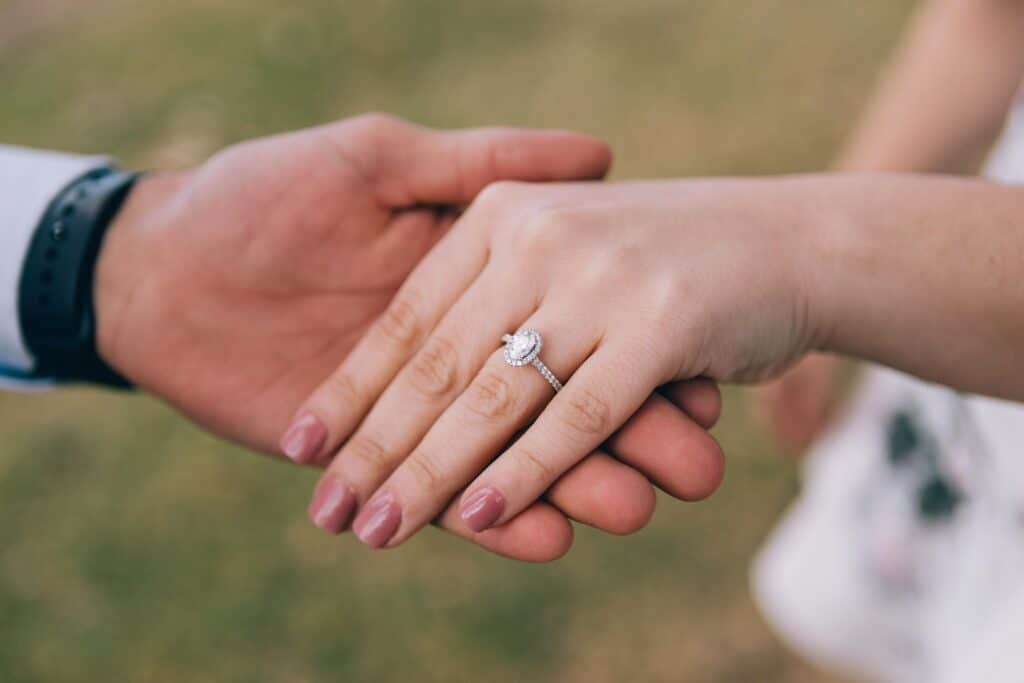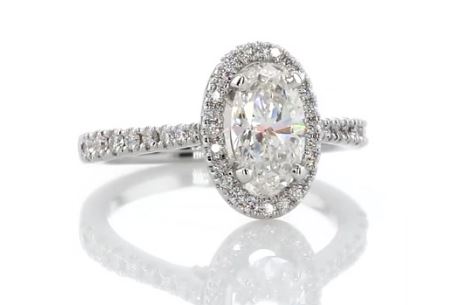Recently, a reader contacted us asking for help buying an oval cut diamond. He mentioned that there wasn’t much selection out there for excellent/ideal cut oval diamonds, and wanted to know if choosing a diamond with a “very good” cut grade was worth it.
Our answer was simple: when it comes to oval cut diamonds, there’s no such thing as an ideal, excellent or very good cut, since the GIA doesn’t give cut grades for these diamonds.
To find a beautiful oval cut diamond, it’s much more important to look at its parameters and work out if it’s well cut. This can require some skill and research, as we’ve explained below.
Here’s the reader’s original message:
“Hi Diamond Pros!
I am looking for an engagement ring! I am looking for an oval cut diamond in a gold halo setting with pave/side stones. It seems there isn’t much out there when it comes to ideal cut oval diamonds, but there seem to be a lot of “Very Good” cuts. Would I be sacrificing too much by buying a Very Good cut?
I have roughly an $8000-$10,000 budget.
Thank you!”
This is an excellent question, and it gives us an opportunity to discuss something that can be a significant source of confusion for diamond buyers — how to find a nicely cut diamond in a fancy shape, such as an oval cut diamond.
Fancy shape diamonds can be challenging to purchase, as the process is much more subjective than it is with a round cut diamond. It’s equally as much about finding something that looks good to your eye as it is about finding a diamond with the right cut grade.
Below, we’ve shared a few characteristics to look for (and look out for) in an oval cut diamond. If you’re interested in this diamond shape, you can either use the information below or contact us for help finding a diamond that meets your specifications.

What to Look for When Buying an Oval Cut Diamond
If you’ve ever read our guide to buying a diamond, you’ll know that we recommend starting with a diamond shape, picking a carat weight, then narrowing your search to only include diamonds with a cut grade of ideal or excellent.
The logic behind this is that cut is by far the most consequential and important of the four Cs, at least from the perspective of a diamond’s appearance. A diamond that’s nicely cut will have lots of light return and exceptional brilliance, while a poorly cut diamond will look dull and lifeless.
This approach works very well for round brilliant cut diamonds, which are graded for cut quality by the GIA. If you’re buying from a vendor like James Allen or Blue Nile, you can simply restrict your search to excellent or ideal cut diamonds, then choose from the available options.
However, with fancy shape diamonds like the oval cut, which don’t receive a cut grade from the GIA and can’t be filtered by cut quality, knowing what to look for can be difficult.
In fact, finding a well-cut oval diamond is particularly difficult, as there’s no magical combination of table % and depth % that guarantees a diamond in this shape will look good.
Before we get into the specifics of what to look for in an oval cut diamond, let’s go over the basics of this shape and address the cut quality information that you can often find for ovals online.
The oval cut is famous for its excellent brilliance and fire, as well as its elongated shape, which can make it appear larger on the wearer’s finger. The oval cut is consistently popular and has produced plenty of headlines — for example, according to Rapaport, an 88 carat oval cut diamond sold for nearly $14 million at auction in 2019, when it was snapped up by a private collector.
Unlike the objective grades given by the GIA or AGS, the cut quality grades you might be able to find online for oval cuts and other fancy shape diamonds are generally the companies’ own subjective grades. In order to make some diamonds look better than others, these companies often give the best grades (“ideal” or “excellent”) to their in-house brand.
Put simply, these grades aren’t reliable and are best ignored. Instead, it’s much better to select an oval cut diamond based on several factors:
- Does it have a visible bowtie effect?
- Does it have the right length to width ratio?
- Are its other parameters okay?
- Does it look good to you?

Let’s start with the first item on the list — the bowtie effect. Because of their elongated shape, it’s common for oval cut diamonds to show a bowtie. This “bowtie” refers to a dark area that covers the center of the diamond, running from the top to the bottom.
A large, prominent bowtie can distract from the natural beauty of an oval cut diamond, making it something that you’ll want to avoid.
Unlike color, clarity and other diamond characteristics, there’s no field on a diamond’s certificate that lists whether or not it has a bowtie. Instead, this is something that you’ll need to look for on your own.
Luckily, you can do this using the 360° view option on James Allen and Blue Nile. Here’s an oval cut diamond from James Allen with an obvious bowtie to serve as an example:

You can see that the bowtie runs vertically along the middle of the diamond. Because the bowtie darkens the diamond and affects its light performance, it’s a characteristic you’ll typically want to avoid when comparing oval diamonds.
For comparison, here is an oval cut diamond with almost invisible bowtie:

Second, let’s address the length to width ratio. While there’s no “perfect” length to width ratio for this type of diamond, oval cut diamonds generally look most appealing when they have a length to width ratio in the 1.30 to 1.50 range.
You can find a diamond’s length to width ratio in the “diamond information” or “diamond details” panel on websites like James Allen or Blue Nile.
Third, let’s go over the other parameters that matter in an oval cut diamond. Although there’s no one-size-fits-all rule for this diamond shape, we generally recommend looking for the following:
- A table percentage of 53 to 63
- A depth percentage of 58 to 62
- A very thin to slightly thick girdle
- Ideally no culet
These are general, loose guidelines, and shouldn’t be viewed as a replacement for looking at a diamond yourself.
Finally, the factor that matters most in an oval cut diamond is that it looks good to you. If you’re considering an oval cut diamond, you’ll want to spend some time comparing different diamonds that match your specifications and budget.
Identifying a well-cut diamond is by far the most difficult part of buying an oval cut diamond. The good news is that the rest of the process is relatively straightforward.
When it comes to diamond clarity, the complex facets of oval cut diamonds make them excellent at hiding inclusions and blemishes. This means that you can choose a modest clarity grade like an SI1 or SI2 and end up with a beautiful diamond that’s free of visible inclusions (i.e. if it’s eye-clean).
As for diamond color, it’s best to stick with a grade of H or better if you prefer a white gold or platinum setting, or J to K if you plan to choose a yellow gold or rose gold setting. These color grades ensure that the diamond will look colorless in relation to its setting.
With these recommendations in mind, you can find some truly stunning oval cut diamonds for approximately $10,000.
For example, this 1.20 carat, G color, VS1 clarity oval cut diamond is available for $8,410. In a pavé halo setting, it makes for a gorgeous engagement ring for $10,000.

Our Recommendation
When it comes to round diamonds, identifying quality is as simple as following a checklist. With oval cut diamonds, the process is different. The objective “rules” matter less and the subjective aspects, such as whether you like a diamond’s appearance, matter much, much more.
To get the best oval cut diamond for your budget, use the 360° image tools provided by James Allen and Blue Nile to filter out poor choices. Be on the lookout for visible bowties or diamonds that appear dull and lifeless. Shortlist diamonds that are brilliant, eye-clean and well-cut.
Since this process can be complicated and subjective, consider reaching out for help from one of our experts. You can contact us any time and we’ll help you to find the right diamond for your tastes and budget.

- No questions asked returns within 30 days of shipment. James Allen will send you a paid shipping label to return the ring.
- Lifetime Warranty
- Free International Shipping
- Free prong tightening, repolishing, rhodium plating and cleaning every 6 months
- Provide insurance appraisals
- One free resizing within 60 days of purchase
- Free ring inscriptions
- Best-in-class high quality imagery of all diamonds in stock
- 24/7 Customer Service
- Best-in-class packaging


- No questions asked returns within 30 days of shipment. Blue Nile will send you a paid shipping label to return the ring.
- Lifetime Warranty
- Free Shipping
- Free prong tightening, repolishing, rhodium plating and cleaning every 6 months
- Provide insurance appraisal
- One free resizing within the first year of purchase
- High quality images of about half of their diamonds
- 24/7 Customer Service
- 100% credit towards future upgrades (must be at least double in value)
- Best in class fulfillment

- Ask a Diamond Pro: Buying a 2 Carat Hearts & Arrows Diamond for $35,000
- 15 Engagement Ring Styles for People Getting Married Before 25
- Ask a Diamond Pro: Chunky Cushion Cut Diamond for $1,000
- Ask a Diamond Pro: Buying a Round Cut Diamond Ring in Australia
- 12 Trend Inspired Birthstone Gifts for April 2024

